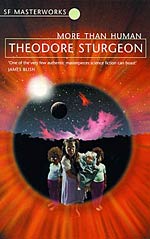
![]() Sable Aradia
Sable Aradia
1/1/2018
![]()
Read for the SF Masterworks Reading Challenge and the Science Fiction Masterworks Book Club.
This might be my favourite book from the SF Masterworks yet.
For one thing, I've read it before. I remembered it when they started talking about a gestalt person; a person who is an amalgamation of people who are greater than the sum of their parts. This is where I learned the term. The characters in this book, born with exceptional psychic abilities, in many ways cannot simply function on their own. They need other people to complete them. So a telepath becomes the "head," a couple of psychokenetics and translocators become the "limbs," an idiot savant becomes the "brain," and a telekenetic become the link between them. The dilemma of the book is the gestalt's struggle to come together and become complete, and their struggle to get along with the rest of humanity while doing so.
I read this for the first time when I was about ten, and forgot the title or author, about the time I was reading a bunch of books with a SFF focus to rate in the Children's Choice Awards. It was an interesting exercise because I didn't catch a lot of things that were going on in the book. Kids just accept things, so there was much I didn't have reason to question. For instance, while I was acutely aware, as a nerdy, bullied child, of much of the loneliness and suffering of the characters, I was unaware that many of them were suffering from horrific child abuse.
So that was more than thirty years ago now. I would say, no matter how clever you are as a child, there are aspects of this book that even the brightest child is not equipped to grasp, and it requires a certain level of adult maturity.
But part of the genius of this novel is an acute understanding of neurodiverse thinking processes. Neurodiverse people (autistic, schizophrenic, etc.) do not think like other people, and Sturgeon has such an intense grasp of this that I wonder if he is himself autistic. It caused me to wonder whether I, who am somewhat like many of these characters, suffer from early childhood induced CPTSD, or if I am mildly autistic but smart enough to mostly cope. I really identified.
There are three protagonists in this novel, one of each of the thinking-feeling parts of the gestalt. The first is Lone, a severely autistic and possibly mentally disabled man who manages to figure out a limited way of engaging with the world because he is also a telepath. The second is Gerry, who is not autistic but who probably suffers from a personality disorder and definitely suffers from feral child syndrome. The third is a former air force engineer, whose ultimate role in the gestalt would be a spoiler.
For much of the book you wonder what's actually going on, because you're in the POV of people who are neurodiverse and who do not interact with the world in the usual way. So you have to keep on reading to figure it out. It's breathtaking in its scope and implications.
Sturgeon asks the question whether having full access to certain dormant parts of the brain - namely, the ones that govern the powers we view as psychic ability - would work differently than a regular brain, and whether that might hinder their interaction with the rest of humanity; at least, until they learn a new way to approach human interaction and society.
I think everyone who wants to understand neurodiversity should read this book, just for that understanding. Never mind the greater science fictional implications, even.
Modern readers may find the 1950s racism awkward, but unusually, it's not distracting; in large part because ALL of the protagonists are outsiders from the dominant culture, and not given the same breath of acceptance that we as humans expect and crave.
In addition, from a purely craft-based standpoint, Sturgeon's metaphors and turns-of-phrase and amazing and always on point.
Seriously, just read it.
http://dianemorrison.wordpress.com